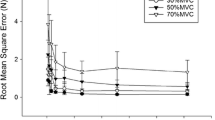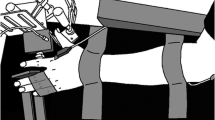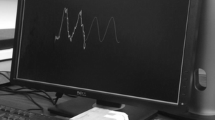Abstract
Theoretically visual gain has been identified as a control variable in models of isometric force. However, visual gain is typically confounded with visual angle and distance, and the relative contribution of visual gain, distance, and angle to the control of force remains unclear. This study manipulated visual gain, distance, and angle in three experiments to examine the visual information properties used to regulate the control of a constant level of isometric force. Young adults performed a flexion motion of the index finger of the dominant hand in 20 s trials under a range of parameter values of the three visual variables. The findings demonstrate that the amount and structure of the force fluctuations were organized around the variable of visual angle, rather than gain or distance. Furthermore, the amount and structure of the force fluctuations changed considerably up to 1°, with little change higher than a 1° visual angle. Visual angle is the critical informational variable for the visuomotor system during the control of isometric force.





Similar content being viewed by others
References
Beuter A, Haverkamp H, Glass L, Carriere L (1995) Effect of manipulating visual feedback parameters on eye and finger movements. Int J Neurosci 83:281–294
Caminiti R, Ferraina S, Johnson PB (1996) The sources of visual information to the primate frontal lobe: a novel role for the superior parietal lobule. Cereb Cortex 6:319–328
Ebner TJ, Fu Q (1997) What features of visually guided arm movements are encoded in the simple spike discharge of cerebellar Purkinje cells? Prog Brain Res 114:431–447
Elble RJ, Koller WC (1990) Tremor. The John Hopkins University Press, Baltimore
Ellermann JM, Siegal JD, Strupp JP, Ebner TJ, Ugurbil K (1998) Activation of visuomotor systems during visually guided movements: a functional MRI study. J Magn Reson 131:272–285
Gibbs CB (1962) Controller designs, interactions of controlling limbs, time-lags, and gains in positional and velocity systems. Ergonomics 17:385–402
Gogel WC, Eby DW (1997) Measures of perceived linear size, sagittal motion, and visual angle from optical expansions and contractions. Percept Psychophys 59:783–806
Hess RA (1973) Nonadjectival rating scales in human response experiments. Hum Factors 15:275–280
Jagacinski RJ, Flach JM (2003) Control theory for humans: quantitative approaches to modeling performance. Lawrence Erlbaum Associates, Mahwah
Jagacinski RJ, Monk DL (1985) Fitts’ Law in two dimensions with hand and head movements. J Mot Behav 17:77–95
Jeannerod M, Arbib MA, Rizzolatti G, Sakata H (1995) Grasping objects: the cortical mechanisms of visuomotor transformation. Trends Neurosci 18:314–320
Jones KE, Hamilton AF, Wolpert DM (2002) Sources of signal-dependent noise during isometric force production. J Neurophysiol 88:1533–1544
Keppel G (1991) Design and analysis: a researcher’s handbook. Prentice Hall, Upper Saddle River
Laidlaw DH, Bilodeau M, Enoka RM (2000) Steadiness is reduced and motor unit discharge is more variable in old adults. Muscle Nerve 23:600–612
Levin CA, Haber RN (1993) Visual angle as a determinant of perceived interobject distance. Percept Psychophys 54:250–259
Milner AD, Goodale MA (1993) Visual pathways to perception and action. Prog Brain Res 95:317–337
Mushiake H, Strick PL (1995) Pallidal neuron activity during sequential arm movemetns. J Neurophysiol 74:2754–2758
Newell KM, McDonald PV (1994) Information, coordination modes and control in a prehensile force task. Hum Mov Sci 13:375–391
Newell KM, Slifkin AB (1998) The nature of movement variability. In: Piek J (ed) Motor control and human skill: a multidisciplinary perspective. Human Kinetics, Champaign, pp 143–160
Pincus SM (1991) Approximate entropy as a measure of system complexity. Proc Natl Acad Sci USA 88:2297–2301
Rosenbluth D, Allman JM (2002) The effect of gaze angle and fixation distance on the responses of neurons in V1, V2, and V4. Neuron 33:143–149
Rougier P, Farenc I, Berger L (2004) Modifying the gain of the visual feedback affects undisturbed upright stance control. Clin Biomech (Bristol, Avon) 19:858–867
Schaab JA, Radwin RG, Vanderheiden GC, Hansen PK (1996) A comparison of two control-display gain measures for head-controlled computer input devices. Hum Factors 38:390–403
Slifkin AB, Newell KM (1999) Noise, information transmission, and force variability. J Exp Psychol Hum Percept Perform 25:837–851
Slifkin AB, Vaillancourt DE, Newell KM (2000) Intermittency in the control of continuous force production. J Neurophysiol 84:1708–1718
Stein JF, Glickstein M (1992) Role of the cerebellum in visual guidance of movement. Physiol Rev 72:967–1017
Stephens JA, Taylor A (1974) The effect of visual feedback on physiological muscle tremor. Electroencephalogr Clin Neurophysiol 36:457–464
Vaillancourt DE, Newell KM (2000) Amplitude changes in the 8–12, 20–25, and 40 Hz oscillations in finger tremor. Clin Neurophysiol 111:1792–1801
Vaillancourt DE, Newell KM (2003) Aging and the time and frequency structure of force output variability. J Appl Physiol 94:903–912
Vaillancourt DE, Larsson L, Newell KM (2002) Time-dependent structure in the discharge rate of human motor units. Clin Neurophysiol 113:1325–1338
Vaillancourt DE, Thulborn KR, Corcos DM (2003) Neural basis for the processes that underlie visually guided and internally guided force control in humans. J Neurophysiol 90:3330–3340
Vaillancourt DE, Mayka MA, Corcos DM (2006) Intermittent visuomotor processing in the human cerebellum, parietal cortex, and premotor cortex. J Neurophysiol 95:922–931
Wickens CD (1984) Engineering psychology and human performance. Merrill, Columbus
Wolpert DM, Miall RC, Winter JL, Stein JF (1992) Evidence for an error deadzone in compensatory tracking. J Motor Behav 24:299–308
Wyman D, Steinman RM (1973) Small step tracking: implications for the oculomotor “dead zone”. Vision Res 13:2165–2172
Acknowledgements
This research was supported in part by grants from the National Institutes of Health (R01-NS52318, R01-HD46918, R03-AG23259). We thank Tim Benner for his technical assistance in setting up the computerized software of the display for the experiment. Pamela S. Haibach is now at SUNY Brockport.
Author information
Authors and Affiliations
Corresponding author
Rights and permissions
About this article
Cite this article
Vaillancourt, D.E., Haibach, P.S. & Newell, K.M. Visual angle is the critical variable mediating gain-related effects in manual control. Exp Brain Res 173, 742–750 (2006). https://doi.org/10.1007/s00221-006-0454-2
Received:
Accepted:
Published:
Issue Date:
DOI: https://doi.org/10.1007/s00221-006-0454-2




